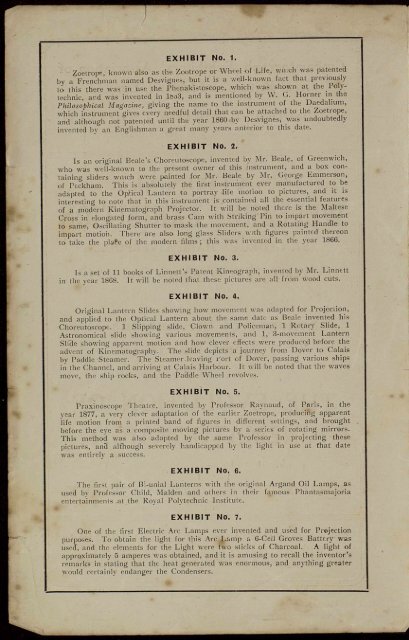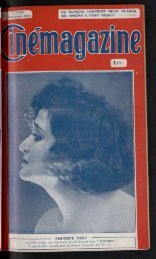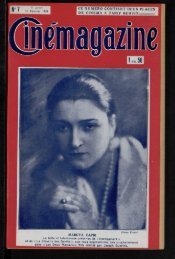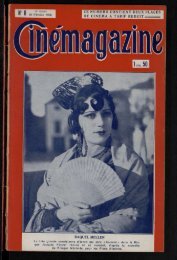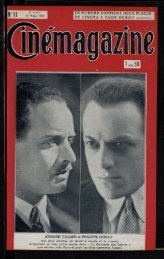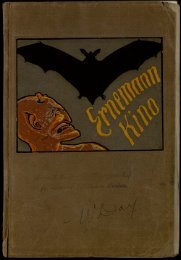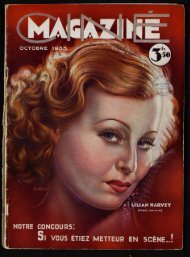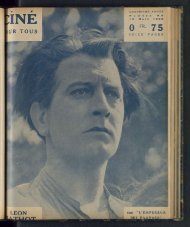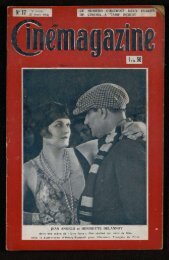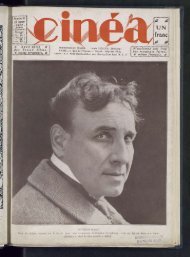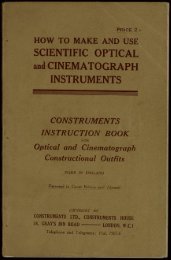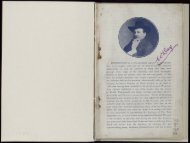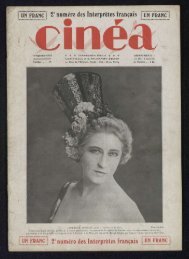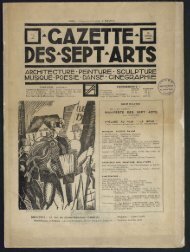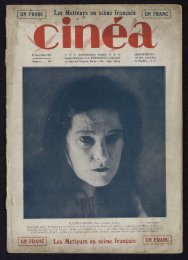WELFARE EXHIBITION
WELFARE EXHIBITION
WELFARE EXHIBITION
Create successful ePaper yourself
Turn your PDF publications into a flip-book with our unique Google optimized e-Paper software.
EXH1BIT NO. 1.<br />
Zoetrope, known also as the Zootrope or Wheel of Life, wn.ch was patentée!<br />
by a Frenchman named Desvignes, but it is a well-known faet that previously<br />
to this there was in use the Phcnakistoscope, whicli was shown at the Polytechnic,<br />
and was invented in lbd3, and is mentioned by W. G. Horner in the<br />
Philosophical Magazine, giving the name to the instrument of the Daedalium,<br />
which instrument gives every needful détail that can be attached to the Zoetrope,<br />
and although not patenled until the year 1860 'by Desvignes, was undoubtedly<br />
invented by an Englishman a great many years anterior to this date.<br />
EXHIBIT NO. 2.<br />
Is an original Beale's Choreutoscope, invented by Mr. Beale, of Greenwich,<br />
who was well-known to the présent owner of this instrument, and a box containing<br />
sliders wmch were painted for Mr. Beale by Mr, George Emmerson,<br />
of Peckham. This is absolutely the lirst instrument ever manufactured to be<br />
adapted to the Opïicàl Lantern to portray life motion to pictures, and it is<br />
interesting to note that in this instrument is contained ail the essential features<br />
of a modem Kinematogrnph Projector. It will be noted there is the Maltese<br />
Cross in elongated form, and brass Cam with Strjking Pin to impart movement<br />
to same, Oscillating Shutter to mask the movement, and a Rotating Handle to<br />
impart motioii. There are also long glass Sliders wi'th figures painted thereon<br />
to take the place of the modem films ; this was invented in the year 1866.<br />
EXHIBIT NO. 3.<br />
Is a set of 11 books of Linnett's Patent Kineograph, invented by Mr. Linnett<br />
in the year 1868. It will be noted that thèse pictures are ail from wood cuts.<br />
EXHIBIT NO. 4.<br />
Original Lantern Slides showing how movement was adapted for Projection,<br />
and applicd to the Optical Lantern about the same date as Beale invented his<br />
Choreutoscope. 1 Slipping slide, Clown and Policeman; 1 Rotary Slide, 1<br />
Astronomical slide showing various movements, and 1, 3-movement Lantern<br />
Slide showing apparent motion and how clever effects were produced before the<br />
advent of Kinematographv. The slide depicts a joumey from Dover to Calais<br />
by Paddle Steamer. The Steamer leaving l'ort of Dover, passing various ships<br />
in the Channcl, and arriving at Calais Harbour. It will be noted that the waves<br />
move, the ship rocks, and the Paddle Wheel revolves.<br />
EXHIBIT No. 5.<br />
Praxinoscope Théâtre, invented by Professor Raynaud, of Paris, in the<br />
year 1877, a very clever adaptation of the earlicr Zoetrope, producing apparent<br />
life motion from a printed banc! of ligures in différent settings, and brought<br />
before the eye as a composite moving pictures by a séries of rotating mirrers.<br />
This method was also adapted by the» same Professor in proieçting thèse<br />
pictures, and although severely handicapped by the light in use at that date<br />
was cntirely a success.<br />
EXHIBIT NO. 6.<br />
The first pair of Bi-unial Lanterns with the original Àrgand Oil Lamps, as<br />
used by Professor Child, Malden and others in their famous Phantasmajoria<br />
entertainments at the Royal Polytechnic Instituts.<br />
EXHIBIT NO. 7.<br />
One of the lirst Electric Arc Lamps ever invented and used for Projection<br />
purposës. To obtain the light for this Arc Lamp a 6-Cell Graves Battery was<br />
used", and the éléments for the Light were fwo sticks of Charcoal. A light of<br />
apprqxirhately 5 ampères was obtained, and it is amusing to recall the inventor's<br />
remarks in staling that the heat generated was enormous, and anything greater<br />
jvould certainly endanger the Condensers.<br />
EXHIBIT No. 8.<br />
The original pièce of paper film produced by Eriese Greene, who is undoubtedly<br />
the inventer of the Kinematograph as we know it to-day. This was<br />
the first lime that ever a séries of Photographs had been taken from one<br />
stafldpoint, on one endless band of film, by one Caméra and recorded so that<br />
Life .Movement Portrayals could be reproduced with the aid of the Optical<br />
Lantern and shown to a tiumber of pcople apparently as they occurred. This<br />
film was takeh on paper in the early efforts of Eriese Greene in the year 1885,<br />
and was used on the first instrument invented by Eriese Greene, and to authenticate<br />
the data it is interesting fo see the telegram which accompanies this<br />
remarkable relie, from the Enginecr Lege, of Hatton Garden, who made this<br />
first instrument for Eriese Greene. The photographs after being fixed were<br />
immersed in Parafiin Wax to render them semi «ransparent, and the subject<br />
was a row of shops with the Sun blinds ont, at Hyde Park Corner, and at this<br />
effort no shutter was used to mask the movement, îience the streaky light effect.<br />
It is also interesting to record that many of dur leadirig manufacturers of<br />
Moving Pîctùre Apparatus, and perfectors of Kinematographv ail take their<br />
data, and were undoubtedly instilled in the ethics of Motion Picture Photographv<br />
by Eriese Greene, such as T. Alva Edison, who is credited with the<br />
invention of Kinematographv, John Wrench, R. Pricstwich, Darling of<br />
Brighton, and many other well-known manufacturers of apparatus.<br />
EXHIBIT NO. 9.<br />
Label taken from an early Kinetoscope invented by Thomas Alva Edison,<br />
who was working on Motion Pictures after receiving correspondence from<br />
Eriese Greene in 1887. This was never patented by this gentleman in this<br />
country, and the first intimation of his work on Living Pictures reached England<br />
in May, 1891, so that undoubtedly although we hâve a great dcal to thank this<br />
wizard of inventive facultv for, it is a façt established beyond any doubt whatever<br />
that he dfd not invent Motion Pictures. The lirst of thèse Kinetoscope<br />
Machines was brought to England by Messrs. Maguire and Borcas, and installée!<br />
in an office in Bishopsgatc Street.<br />
EXHIBIT NO. 10.<br />
One of the original séries of films manufactured by Mr. Edison in his<br />
carliest productions, showing the exact length of films at that period, namely,<br />
r> fret, and showing the Edison Standard (.auge, namely, four perforations per<br />
picture, which gauge lias been since universally adapted nie world over. The<br />
Film shows a scène in a Blacksmith's shop, and was produced about the year<br />
1891.<br />
EXHIBIT No. 11.<br />
One Lumière Fire Proof Film Box, made to-take the standard length of<br />
film of that period, namely, 45 feett, and was invented about 1898.<br />
EXHIBIT NO. 12.<br />
A p'ortion of the first film ever takeh by Mr. Bert Acres for R. W. Paul,<br />
who manufactured the first commercial i rojectors in this country, and showeel<br />
his first Kinematograph Pictures at Einsbury Technical Collège on February<br />
20th, 1896. It will be noted that the perforations are not correctly centred.<br />
This fact is attributcd to the early film manufactured by Mr. Paul being<br />
perforated by a hand punch, having 32 teeth on either siele, which in use<br />
sometimes came truc, and sometimes did not.<br />
EXHIBIT No. 13.<br />
An Animatograph Maltese Cross Projector, manufactured by R. W. Paul<br />
in the year 1903, showing how much advanced in constructional détails this<br />
machine was over ail others of the period. This was one of the last efforts of<br />
this well-known mechanic, who did so much to produce Motion Pictiire<br />
Apparatus, and to him undoubtedly must be credited the fullest mede of praise<br />
for his early efforts in producing Caméras, Projectors, and ail necessary<br />
apparatus for Tue projection of Motion Pictures, w'hîch he started after showing<br />
an Edison Kinetograph early in the year 1895.


